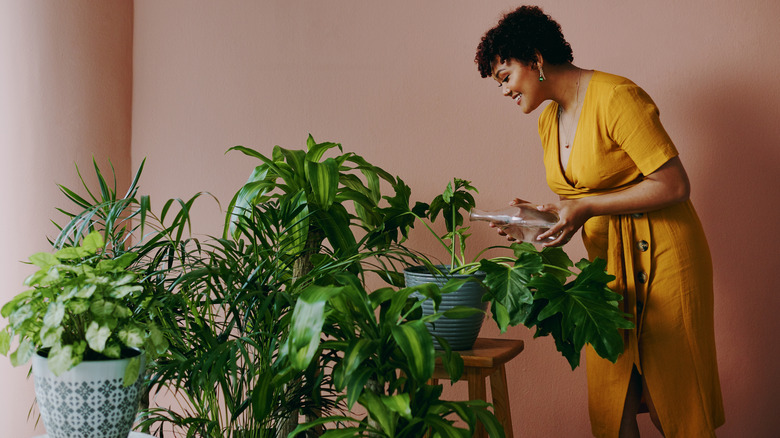Hydration is essential for plants, as it plays a crucial role in various physiological processes necessary for them to grow and thrive. Water is a key component in photosynthesis, the process through which plants convert light energy into chemical energy, producing oxygen and carbohydrates. Like humans, plants are made up mostly of water, sometimes even as much as 95% (via Arizona State University). In this way, water facilitates nutrient absorption from the soil through the plant’s roots. Insufficient water can lead to wilting, reduced nutrient uptake, and ultimately, plant death. Conversely, excess water can lead to root rot by depriving roots of oxygen. Therefore, maintaining a balanced and consistent water supply is vital for optimal plant health and productivity. Believe it or not, watering your houseplants with a diluted Castile soap solution is one simple way you can ensure that they retain hydration between waterings.
Castile soap is an all-natural soap traditionally made from plant-based oils, notably olive oil, which provides gentle cleansing without synthetic additives or animal fats. The soap’s origin and minimal ingredient list contribute to its “all-natural” label. Castile soap has gained popularity for its versatility, serving as a biodegradable, eco-friendly product. It’s for these reasons that many plants can tolerate it as a remedy for eliminating certain pests, like spider mites, and conveniently, it also serves as a method to aid your plants in water retention.
How and why to apply castile soap to your plants

To use Castile soap for plant hydration, create a diluted solution by combining a tablespoon of liquid Castile soap with a gallon of water. Mix thoroughly in a container. Ensure the soap is free of any additives like fragrances or preservatives, as these can harm plants. Transfer the solution to a watering can for easy application. Before applying the Castile soap solution, water your plants thoroughly first. Wetting agents, like Castile soap’s function here, are better absorbed with damp soil. After pre-wetting the soil, you can water your plants with the soap solution. However, it’s a good idea to use Castile soap in moderation as a wetting agent, because overuse of the soap can harm plants, especially those with sensitive roots or foliage.
Turf Titan recommends using a surfactant, like Castile soap, to help your plants remain hydrated when the soil has become hydrophobic. Hydrophobic soil is soil that repels water, retaining it poorly after completely drying out between waterings. Hydrophobic soil is easy to recognize in your potted plants. When you water them and the water immediately rushes out of the drainage holes instead of saturating the soil, your potting medium has become hydrophobic. Another sign is when water beads on the soil instead of absorbing into it. Nevertheless, amending the soil with a wetting agent like Castile soap has the power to help your soil more readily absorb moisture which will help hydrate your thirsty plants.
How to keep your plants hydrated longer
Castile soap helps keep plants hydrated longer due to its surfactant properties. Surfactants reduce the surface tension of water, allowing it to spread more evenly and be absorbed by the plant’s roots. This is particularly useful in preventing water runoff and ensuring that water and nutrients reach the plant’s root system effectively. That being said, while there is some research that supports wetting agents increasing plant hydration, there isn’t much readily available specifically advocating for soaking plants in Castile soap solutions regularly.
Alternatives for keeping plants hydrated include organic mulches, such as straw or wood chips, which help retain soil moisture and regulate temperature. Watering practices, like deep watering and mulching, can also contribute to water conservation in plants. Ultimately, the choice of hydration method depends on factors like plant type, climate, and individual preferences. While Castile soap can be a useful aid, it’s essential to consider the specific needs of each plant and adopt a holistic approach to plant care that includes proper watering techniques, soil amendments, and environmental considerations.